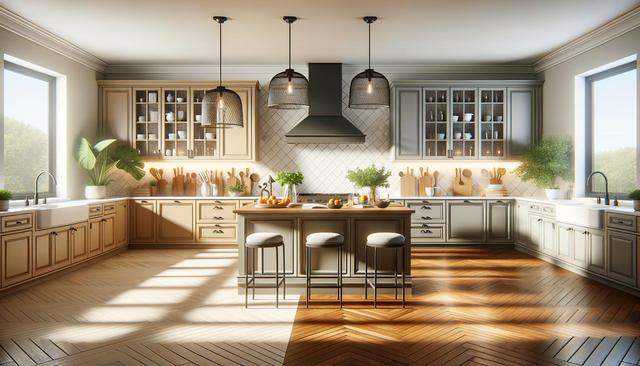Two Colour Combinations That Elevate Your Kitchen Design
A kitchen remodel can breathe new life into your home. By updating appliances, cabinets, and countertops, you can create a more functional and stylish space.Planning ahead ensures the best results within your budget.

Why Colour Combinations Matter in Kitchen Design
Colour plays a pivotal role in shaping the atmosphere and aesthetic of any space, and the kitchen is no exception. Choosing the right two-colour combination can dramatically influence how high-end your kitchen looks and feels. While trends come and go, certain pairings have a timeless appeal and can enhance everything from layout to lighting. A well-thought-out colour scheme can draw attention to architectural details, highlight modern appliances, and make the space feel cohesive and inviting.
When selecting colours, it is essential to consider natural light, your kitchen’s size, and the materials used in cabinets and countertops. For instance, lighter colours can make a small kitchen appear more spacious, while darker tones can add depth and richness. By combining complementary hues, homeowners can achieve a balance of elegance and functionality that enhances the overall value of their home.
Classic White and Deep Navy
One of the most timeless two-colour combinations for kitchens is classic white paired with deep navy. This duo exudes sophistication and works well in both traditional and contemporary settings. The crispness of white cabinetry contrasts beautifully with navy islands or lower cabinets, creating a striking visual impact.
This colour pairing offers several advantages:
- White helps reflect natural and artificial light, making the kitchen feel brighter and more open.
- Navy introduces a grounded, luxurious feel without being overpowering.
- Both colours act as a neutral base, allowing you to easily incorporate metallic accents or natural wood elements.
To enhance this combination, consider using brass or matte black hardware for a refined finish. Backsplashes in white subway tile or marble with blue veining can tie the look together, while wooden flooring or open shelving adds warmth and texture to the overall design.
Warm Grey and Muted Sage Green
For those seeking a more organic and calming atmosphere, warm grey and muted sage green make a harmonious and high-end duo. This combination is perfect for kitchens aiming to achieve a balance between modern minimalism and natural warmth. Grey offers a sleek, understated backdrop, while sage green introduces subtle colour inspired by nature.
Why this pairing works so well:
- Sage green adds a soft pop of colour without overwhelming the space.
- Warm grey complements stainless steel appliances and stone countertops seamlessly.
- Both tones work beautifully with natural textures like rattan, ceramic, or light wood.
This palette is especially well-suited for open-plan living areas where the kitchen flows into the dining or living room. It creates a unified, calming effect that doesn’t distract from other design elements. Consider using grey for cabinets and sage for walls or accents like bar stools and tiles to maintain visual balance.
Tips for Integrating Two-Colour Palettes
Executing a two-colour scheme effectively requires attention to detail and careful planning. The goal is to create harmony, not competition, between the chosen hues. Here are some practical tips to help integrate your colour choices seamlessly:
- Use one colour as the dominant tone and the other as an accent to avoid visual clutter.
- Ensure that the colours complement your lighting — both natural and artificial.
- Balance the palette with neutral elements like countertops, flooring, and backsplashes.
Incorporating texture is another way to elevate a two-colour kitchen. Matte and glossy finishes can play off each other, adding depth and interest. Don’t be afraid to test paint samples and consider swatches in different lighting conditions before making final decisions. Small details such as trim colour or the shade of grout can also influence the overall look.
Maintaining a Luxurious Look Over Time
Once you’ve chosen your colour palette, maintaining its visual appeal is key to preserving that high-end look. Certain colours may show wear more easily than others, so it’s important to choose durable finishes and easy-to-clean surfaces. Using high-quality paint and materials will ensure that the colours remain vibrant and the surfaces stay in good condition.
Here are a few maintenance tips to keep in mind:
- Use cabinet paint that resists stains and chips.
- Install backsplash tiles that are easy to wipe clean.
- Choose flooring that withstands high traffic and moisture.
Regular upkeep like cleaning smudges, polishing hardware, and checking for scuff marks can go a long way in preserving the elegance of your kitchen. Introducing houseplants, updated lighting, or seasonal decor can also refresh the look without changing the core colour scheme.
Conclusion: Choosing Colours for Long-Term Impact
When thoughtfully selected, two-colour combinations can significantly enhance the aesthetic and functionality of your kitchen. Whether you opt for the timeless contrast of white and navy or the soothing blend of grey and sage, these palettes offer both style and substance. They allow you to personalize your space while maintaining a sense of harmony and sophistication.
For homeowners planning a remodel, considering colour combinations early in the design process can help guide other decisions such as cabinetry, appliances, and fixtures. A cohesive colour scheme not only boosts visual appeal but also contributes to a more enjoyable and efficient cooking environment. By focusing on balance, contrast, and durability, you can create a kitchen that feels both welcoming and refined for years to come.